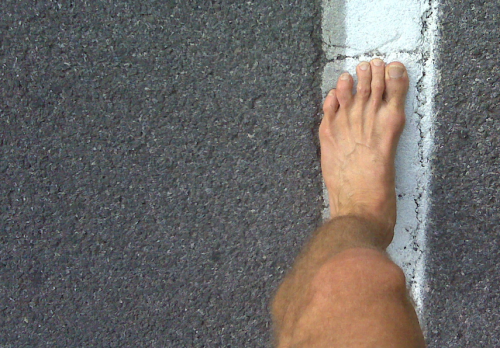
What does a runner who likes to occasionally go out in his bare feet dream of on a scorching-hot summer day? Cold beer? Watermelon? A dip in the Shenandoah river?
All of these are great but a fresh white line of paint is even better. This is the main road near my home in Shepherdstown West Virginia. Shepherd Grade Road is a beautiful winding country road and pleasant for long runs. This week we have had the hottest week on record here. To my delight I was greeted by this fresh white line this week. Smooth and cool.
After I got back from my run, I emailed Ian Adamson, also smooth and cool, who is a science advisor for the Natural Running Center and director of research and education at Newton Running, for his more analytical take on running on hot asphalt. I should add that Ian raced in the Badwater Ultramarathon in Death Valley last summer, finishing the 135-mile race in 34 and 1/2 hours, ten hours behind winner Zach Gringerich– but was the first masters runner (45+).
Of course, Ian didn’t go barefoot in Death Valley! He used three pairs of Newton Shoes– a Distance Racer, Gravity Trainer and Sir Isaac, and rotated these depending on terrain. (See interview with Ian here about the race.)

Now for some Ian:
It seems like the white line is cooler when you are running Badwater. No data that I know of, but solar reflectance numbers back this up. White surfaces reflect significantly more solar radiation than black, approximately 80% reflected compared with 5%. In terms of heat, this translates to a temperature rise of 14.6F for standard white in full sun and 90.0F for standard black.
Surface color, texture and thermal properties all play a part, but as a rough guide, a newly painted white line on a very dark bitumen black top will absorb about 80% less heat than the road. Using the numbers above and a starting temperature of 70F (in the morning), a white line will get to about 85F and the blacktop to 170F from solar radiation pretty quickly. Obviously the white line will absorb heat from the road as well. On a 100 degree day this would be approximately 115F and 200F respectively.
In Death Valley in summer, the road should reach about 220F and the white line about 135F. Actual numbers are slightly lower for the road since it is grey, not black.

I’m glad you wrote about this.
As a runner gradually toughening my feet for barefoot running, (much of it in state parks and national parks), I’ve found that running on the double yellow tends to be cooler and smoother than the asphalt. The yellow lines also make it easier to spot small rocks before I step on them. I am fortunate, because in the parks and country roads there is less traffic to avoid. The Double Yellows are a friendly path for my novice bare feet.
Keep up the good input!
Robin
Good to see someone thinking logically and adapting to the environment. I doubt you will have to worry about the co-efficient of friction on the white paint – cyclists hate it and watch the T de F, there have been many a good spill because of the smooth paint – anyhow, I would doubt anyone is running fast enough to slip – but take it into consideration, Good strong feet brought about by exercise (conscious or subconscious, see Barefoot Sceince insoles)and proper form should ensure adequate traction.
D.
Thanks for the note….definitely not running fast enough to slip. this is barefoot running…all relaxed and smooooooth. no friction.
Mark